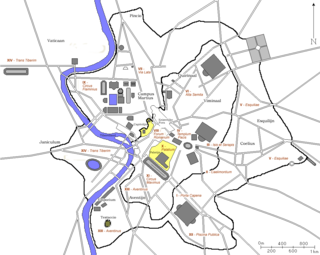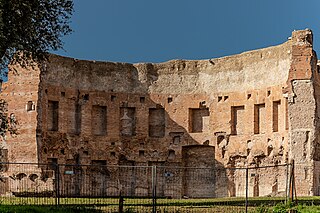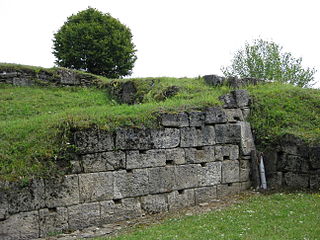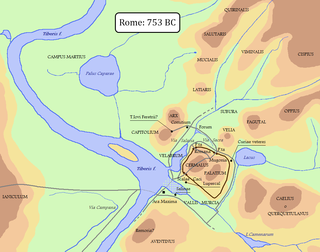Related Research Articles

The founding of Rome was a prehistoric event or process later greatly embellished by Roman historians and poets. Archaeological evidence indicates that Rome developed from the gradual union of several hilltop villages during the Final Bronze Age or early Iron Age. Prehistoric habitation of the Italian Peninsula occurred by 48,000 years ago, with the area of Rome being settled by around 1600 BC. Some evidence on the Capitoline Hill possibly dates as early as c. 1700 BC and the nearby valley that later housed the Roman Forum had a developed necropolis by at least 1000 BC. The combination of the hilltop settlements into a single polity by the later 8th century BC was probably influenced by the trend for city-state formation emerging from ancient Greece.

The seven hills of Rome east of the river Tiber form the geographical heart of Rome, within the walls of the city.

In Sabine and ancient Roman religion and myth, Luna is the divine embodiment of the Moon. She is often presented as the female complement of the Sun, Sol, conceived of as a god. Luna is also sometimes represented as an aspect of the Roman triple goddess, along with Diana and either Proserpina or Hecate. Luna is not always a distinct goddess, but sometimes rather an epithet that specializes a goddess, since both Diana and Juno are identified as moon goddesses.

The Sabines were an Italic people who lived in the central Apennine Mountains of the ancient Italian Peninsula, also inhabiting Latium north of the Anio before the founding of Rome.

The Aventine Hill is one of the Seven Hills on which ancient Rome was built. It belongs to Ripa, the modern twelfth rione, or ward, of Rome.

Marcus Terentius Varro was a Roman polymath and a prolific author. He is regarded as ancient Rome's greatest scholar, and was described by Petrarch as "the third great light of Rome". He is sometimes called Varro Reatinus to distinguish him from his younger contemporary Varro Atacinus.
Vatican Hill is a hill in Rome, located on the right bank of Tiber river, opposite to the traditional seven hills of Rome. The hill also gave the name to Vatican City. It is the location of St. Peter's Basilica.

The Esquiline Hill is one of the Seven Hills of Rome. Its southernmost cusp is the Oppius.

In ancient Roman religion and mythology, Tellus Mater or Terra Mater is the personification of the Earth. Although Tellus and Terra are hardly distinguishable during the Imperial era, Tellus was the name of the original earth goddess in the religious practices of the Republic or earlier. The scholar Varro (1st century BC) lists Tellus as one of the di selecti, the twenty principal gods of Rome, and one of the twelve agricultural deities. She is regularly associated with Ceres in rituals pertaining to the earth and agricultural fertility.

The Servian Wall is an ancient Roman defensive barrier constructed around the city of Rome in the early 4th century BC. The wall was built of volcanic tuff and was up to 10 m (33 ft) in height in places, 3.6 m (12 ft) wide at its base, 11 km (6.8 mi) long, and is believed to have had 16 main gates, of which only one or two have survived, and enclosed a total area of 246 hectares. In the 3rd century AD it was superseded by the construction of the larger Aurelian Walls as the city of Rome grew beyond the boundary of the Servian Wall.

The Suburra, or Subura was a vast and populous neighborhood of Ancient Rome, located below the Murus Terreus on the Carinae and stretching on the slopes of the Quirinal and Viminal hills up to the offshoots of the Esquiline.

In 7 BC, Augustus divided the city of Rome into 14 administrative regions. These replaced the four regiones—or "quarters"—traditionally attributed to Servius Tullius, sixth king of Rome. They were further divided into official neighborhoods.

The Baths of Trajan were a massive thermae, a bathing and leisure complex, built in ancient Rome and dedicated under Trajan during the kalendae of July 109, shortly after the Aqua Traiana was dedicated.

Murus Dacicus is a construction method for defensive walls and fortifications developed in ancient Dacia sometime before the Roman conquest. It is a mix between traditional construction methods particular to Dacian builders and methods imported from Greek and Roman architecture and masonry, and – although somewhat similar construction techniques were used before, during and long after the period – it has peculiarities that make it unique.

Carinae was an area of ancient Rome. It was one of its most exclusive neighborhoods, where many of the senatorial class lived.
Florus described the Carinae as the "most celebrated part of the city".

The Oppian Hill is the southern spur of the Esquiline Hill, one of the Seven hills of Rome, Italy. It is separated from the Cispius on the north by the valley of the Suburra, and from the Caelian Hill on the south by the valley of the Colosseum. The Oppius and the Cispius together form the Esquiline plateau just inside the line of the Servian Wall.

The Velia — or Velian Hill or Velian Ridge — is a saddle or spur stretching out from the middle of the north side of the Palatine Hill towards the Oppian Hill in Rome.

Roma quadrata was an area or structure within the original pomerium of the ancient city of Rome, probably the Palatine Hill with both its Palatium and Cermalus peaks and their slopes. It apparently dated to the earliest stage of the city's formation. The original meaning had already become obscure to both Latin and Greek historians by the late Roman Republic.
Iana is the name of an ancient Roman goddess associated with arches and the moon, usually identified as either a form of Diana or the female counterpart of Janus.

The Argiletum was a street in ancient Rome, which crossed the popular district of Suburra up to the Roman Forum, along the route of the current Via Leonina and Via della Madonna dei Monti.
References
- ↑ Varro De Lingua Latina 5.48
- ↑ L. Richardson, jr (1 October 1992). A New Topographical Dictionary of Ancient Rome. JHU Press. pp. 373–. ISBN 978-0-8018-4300-6.
- ↑ Thomas Henry Dyer (1864). Ancient Rome: With a map of ancient Rome and numerous illustrations. Walton and Maberly. pp. 105–.
- ↑ Pinza Bullettino della Commissione Archeologica Comunale di Roma 1898:93; 1912:86-7.